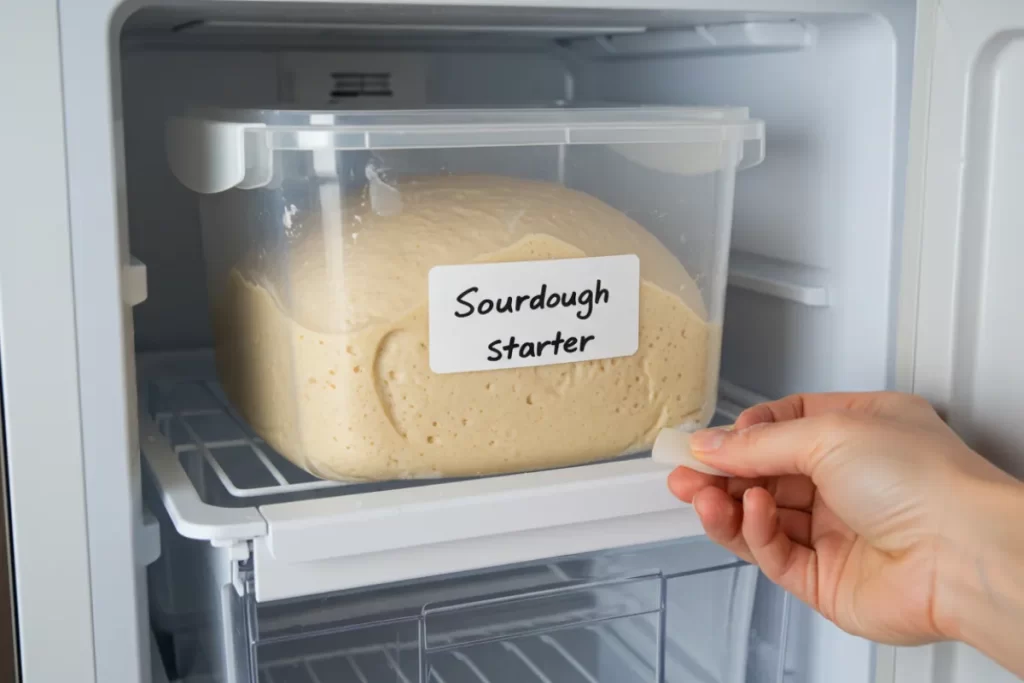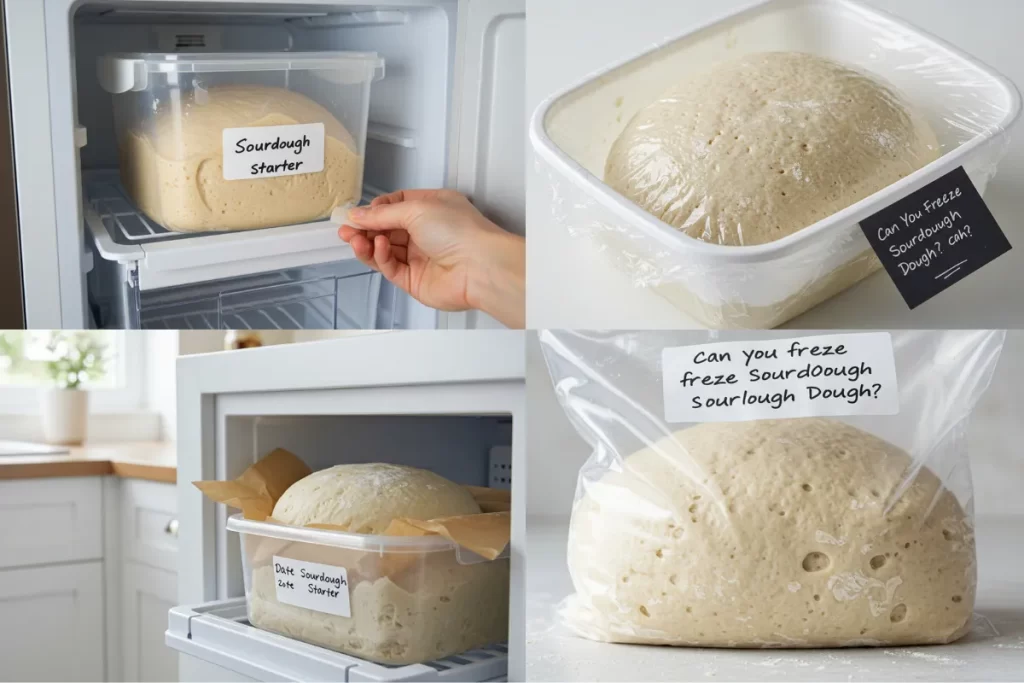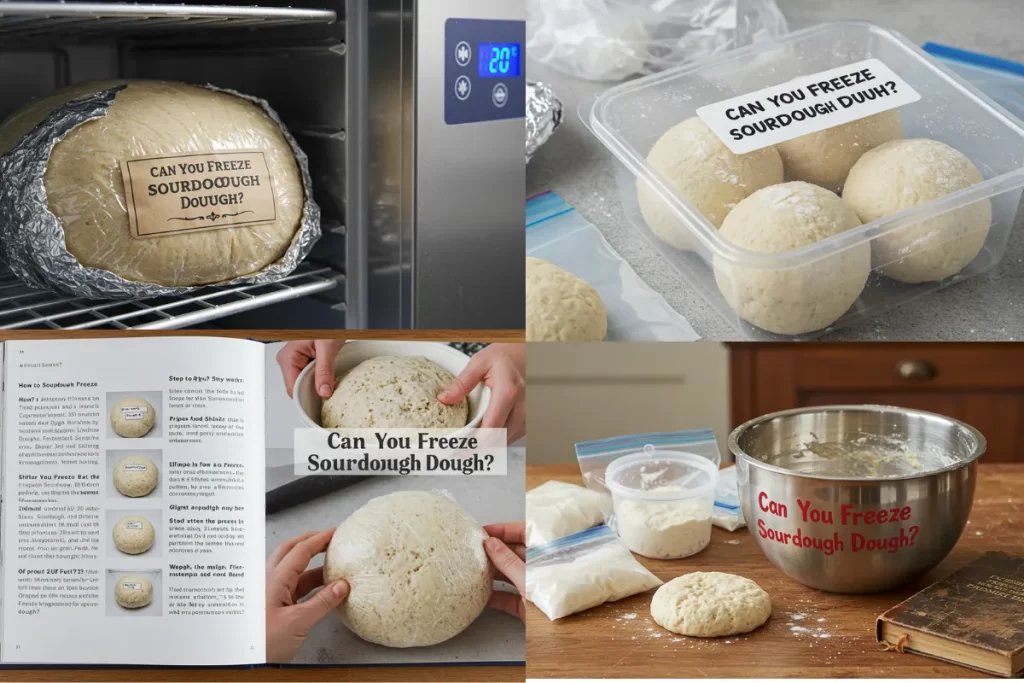Table of Contents
can you freeze sourdough dough? Sourdough bread is a beloved, homemade treat known for its tangy flavor and chewy texture. But what if you don’t have the time to bake fresh bread every day? Can you freeze sourdough dough to enjoy later? The answer is yes! Freezing sourdough dough is an easy, quick way to have fresh sourdough bread. It saves the effort of starting from scratch each time. This guide will teach you all about freezing sourdough dough. We’ll share the best tips and tricks to ensure your sourdough bakes perfectly when you’re ready to use it.
What is Sourdough Dough?

Before the freezing process, let’s review what makes sourdough dough unique. Sourdough is made with wild yeast and bacteria, unlike store-bought yeast-based doughs. This gives sourdough its distinctive tang and chewy texture. The dough is typically slow to ferment, which means it needs a longer rise time than regular bread dough. The sourdough starter is key. It has natural yeast and bacteria. They help the dough rise and develop flavor.
Now that you understand sourdough dough, let’s talk about freezing it!
Can You Freeze Sourdough Dough?

Yes, you can absolutely freeze sourdough dough! In fact, freezing sourdough dough can save you time and effort in the future. Freezing dough preserves its flavor and texture. You can then enjoy fresh, homemade sourdough bread. You won’t need to make the dough each time you want a loaf.
The best part? You can freeze sourdough dough at different stages of the process, whether it’s before or after it has risen. You can even freeze it after shaping it into a loaf or dough balls. This is convenient for baking just one loaf at a time.
Why Freeze Sourdough Dough?
There are several reasons why freezing sourdough dough is a great idea:
- Convenience: You can freeze the dough for later use and bake it when you need it. This is perfect for busy days when you want homemade bread but don’t have the time to make it from scratch.
- Bulk Baking: If you enjoy baking sourdough, try freezing the dough. It lets you make a big batch of dough ahead of time. Then, you can bake fresh bread later.
- Reduced Waste: Freezing extra dough means you don’t have to throw away leftover dough. Instead, you can store it in the freezer and use it later.
Best Tips for Freezing Sourdough Dough

To get the best results when freezing sourdough dough, it’s essential to follow a few key steps. These tips will help maintain the dough’s texture and flavor when you thaw and bake it later.
1. Freeze Dough After Bulk Fermenting
One of the best times to freeze sourdough dough is after it has completed its bulk ferment—the first rise. At this stage, the dough has developed its flavor and structure, making it ready for freezing. Just divide the dough into portions. Then, place each portion in a freezer-safe bag or container.
2. Shape the Dough Before Freezing
You can also shape the dough into loaves or individual dough balls before freezing. This step is especially helpful if you want to bake a loaf or two at a time. Shape the dough into a loaf or divide it into smaller portions, then wrap it in plastic wrap or place it in a ziplock bag. This will help protect the dough from freezer burn and keep it fresh until you’re ready to bake it.
3. Use Plastic Wrap for Protection
To avoid freezer burn, it’s crucial to wrap the dough properly. Use plastic wrap or a freezer-safe bag to wrap the dough tightly. If you’re freezing a whole loaf of sourdough bread, wrap it in plastic wrap and then in aluminum foil. This extra layer of protection keeps the dough from losing moisture and flavor while it’s in the freezer.
4. Freezing Dough in Portions
If you don’t want to freeze a whole loaf, freezing smaller portions of dough works perfectly. You can divide the dough into individual portions, such as pizza or sandwich dough balls. This way, you can remove just the right amount of dough from the freezer without thawing a whole batch.
5. Label and Date Your Dough
It’s always a good idea to label your frozen dough with the date you froze it. This helps you keep track of how long it’s been in the freezer and ensures you use it before it loses its quality. Dough can be stored in the freezer for up to 3 months, but the sooner you use it, the better the flavor and texture will be.
How to Thaw Sourdough Dough from the Freezer

Now that your dough is safely frozen, you’ll want to know how to thaw it for baking. The process of thawing sourdough dough is just as important as freezing it, so here are a few methods to follow.
1. Thaw in the Fridge for Slow Defrosting
The best way to thaw sourdough dough is in the fridge. Defrosting in the fridge takes time—usually 6 to 18 hours. But, it’s a gentle process. It revives the dough without affecting its texture. Simply remove the dough from the freezer and place it in the fridge overnight. When you’re ready to bake, let the dough sit at room temperature for 30 minutes before proofing.
2. Thaw at Room Temperature for Quicker Results
If you’re short on time, you can thaw sourdough dough at room temperature. However, this method is faster, and you’ll need to keep an eye on the dough to make sure it doesn’t overproof. Let the dough sit on the counter for a few hours until it has thawed completely. Once it’s thawed, proceed with proofing as you would with freshly made dough.
3. Proof After Thawing
After the dough has thawed, it’s time for the final proofing stage. Allow the dough to rise again, even if it’s already had one proof before freezing. This step makes sure the dough has enough gas to rise in the oven. It gives you a beautiful oven spring and airy texture. The final proofing time will depend on the temperature and the dough. It usually takes about 1-2 hours at room temperature.
Baking Frozen Sourdough Dough

Once your dough is thawed and has proofed properly, it’s time to bake it! There are a few key things to keep in mind when baking frozen sourdough.
1. Baking from Frozen
You can bake frozen sourdough dough without thawing it. But, you’ll need to adjust the baking time and temperature. Place the frozen dough in a preheated oven at 375°F. Bake it for 1-2 extra minutes to ensure it’s cooked through.
2. Bake After Proofing
If you’ve allowed the dough to thaw and proof, you can proceed with baking as you normally would. Simply preheat your oven and bake the sourdough as usual. The dough will rise beautifully. The result will be a fresh, chewy sourdough loaf.
3. Consider the Oven Spring
When baking frozen sourdough dough, watch for oven spring. It is the final rise that occurs when the dough hits the hot oven. This is what gives sourdough its signature airy texture. If your dough has been properly proofed and baked, you’ll get the perfect loaf with a crisp crust and tender crumb.
Also Read: Can You Freeze Olive Oil? Tips for Freezing & Storing Oil
Final Thoughts on Freezing Sourdough Dough
Can you freeze sourdough dough? Freezing sourdough dough saves time. It ensures you have fresh, homemade bread. You can freeze the dough before or after proofing. The process is simple and effective. Just make sure to follow the proper freezing and thawing methods to maintain the dough’s quality. These tips will let you enjoy fresh sourdough bread anytime. You won’t have to start from scratch every time.
This guide will help you freeze your sourdough dough with confidence. You can then enjoy the delicious results whenever you’re ready to bake. It’s a great way to make sure you always have fresh bread on hand, and it’s a fantastic strategy for meal prep and busy days. So, go ahead—freeze your dough, and enjoy fresh sourdough bread at any time!




